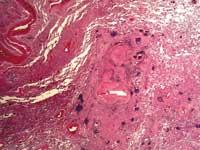Genome sequencing of leprosy bacteria
2001/02/23 Galarraga Aiestaran, Ana - Elhuyar Zientzia

When analyzing the genome of Mycobacterium leprae, it has been observed that during evolution the bacteria have suffered losses in their genome. It retains only the genes essential for its survival and uses host cell infrastructure to meet its needs. It has achieved this in thousands of years of adaptation to human beings.
Many of these lost genes were related to metabolism, so it multiplies so slowly. This low rate of multiplication was an inconvenience in the investigation of gravel treatments. In fact, while Escherichia coli is divided every 40 minutes, leprosy bacteria only multiply every two weeks.
The study of the bacterial genome has allowed to know the mutations that give resistance to antibiotics. In this way, they have managed to develop a new resistance detection test that results in two or three days. With the method so far, it was necessary to see how the patient's blood samples were injected into the laboratory mice and responded to antibiotics. Given that the bacteria need fourteen days to reproduce, the benefits of the new test are evident.
New treatments are now being investigated, as antibiotic treatment is very long and heavy. It can last from six months to two years, so in some countries where health services are underdeveloped, treatment is often interrupted. Therefore, the main objective of the researchers is to get the vaccine, as it would be the most effective way to fight the disease.
Mycobacterum tuberculosis is a bacterium that produces tuberculosis and being of the family of the legendary have many similarities. The TB vaccine has also been somewhat effective against leprosy. Once the genomes of both are known, the challenge for the future of researchers is to develop a double vaccine against both diseases.

Gai honi buruzko eduki gehiago
Elhuyarrek garatutako teknologia






